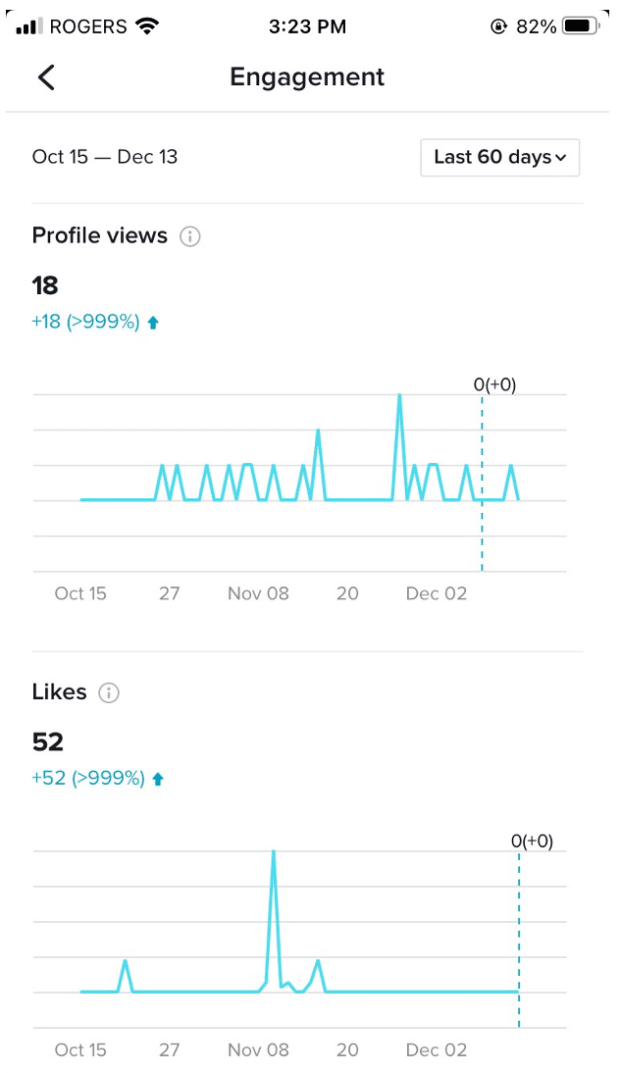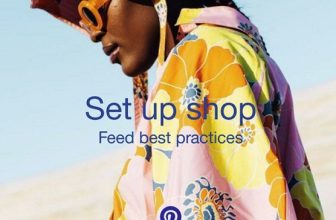What is Social Media Analytics? Everything You Need to Know
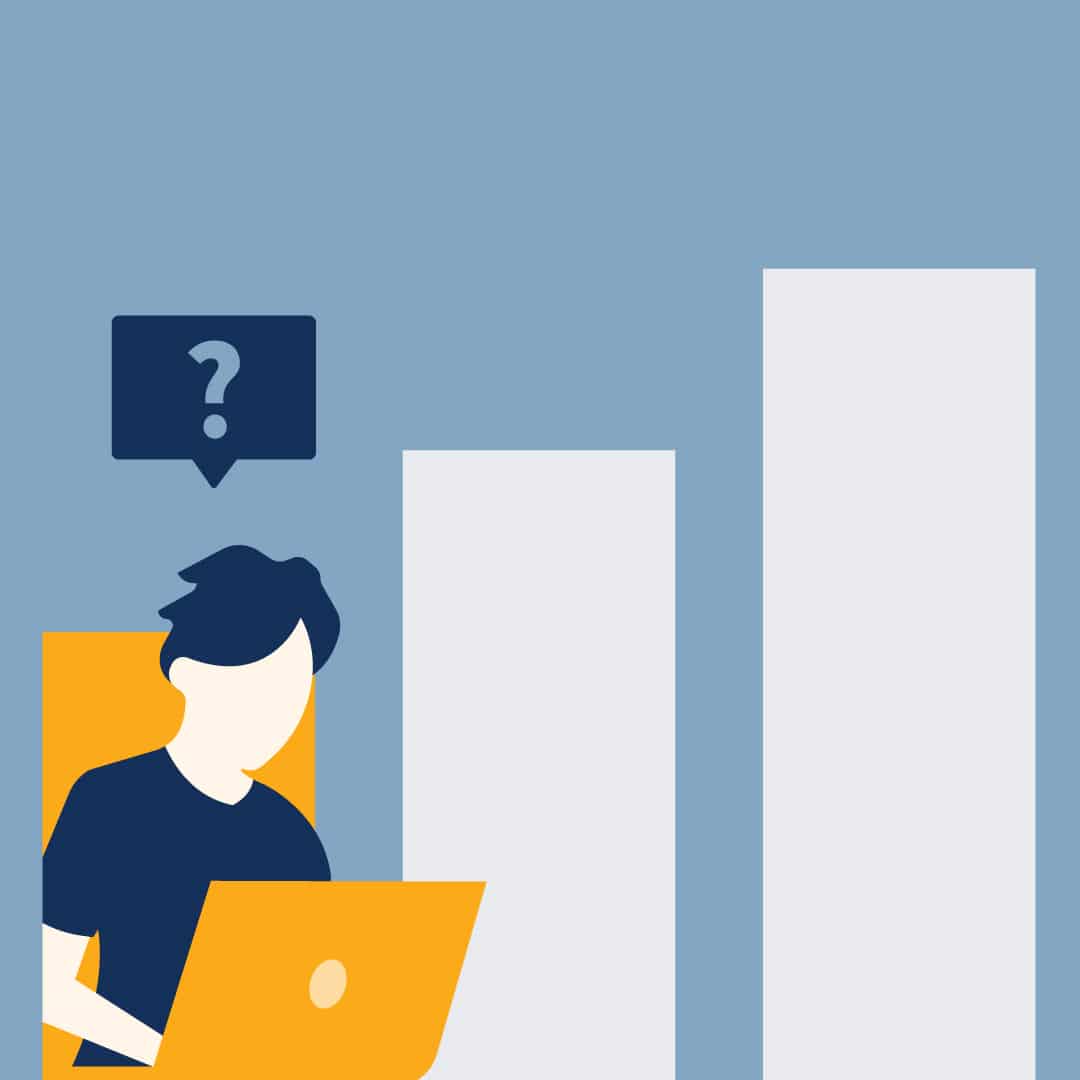
[ad_1]
It’s one thing to know in your heart that you’re a social media whiz: it’s another to be able to prove it. Which is why social media analytics are so critical to any successful campaign or brand strategy.
Data keeps you on track to achieve your social media goals, proving what’s working and — just as importantly — what’s not. Read on to dig into how to track social media analytics and social post analytics, and why these numbers are key to unlocking your engagement and reach.
What is social media analytics?
Social media analytics is the collection and analysis of data points that help you measure the performance of your social media accounts.
These are the metrics that will help you assess your social media marketing strategy on both macro and micro levels. Besides helping you see how social media is contributing to your larger business goals, they can also help you gauge customer sentiment, spot trends, and avoid PR crises before they happen.
To track social media analytics, you’ll look at likes, comments, shares and saves, but you might also monitor mentions and discussion of your brand or consumer insights by practising social listening.
Social media analytics tools help you do all this math, while also creating performance reports to share with your team, stakeholders, and boss — to figure out where you’re succeeding and where you’re struggling.
How to track social media analytics
It may seem like a daunting task, but tracking your social media analytics isn’t difficult. It just requires a little bit of planning and a lot of consistency. You’ve got this!
We’ve even made a template for you to plug your social media analytics report into at the end of this post.
Set S.M.A.R.T. Goals
It’s pretty much impossible to measure your success if you don’t actually know what success looks like. So great social media tracking begins with setting a goal for your brand.
To be clear: a social media goal is not the same thing as a social media strategy (although both are important).
A social media goal is a statement about something specific you want to achieve with your marketing activity. Your goal can be applied to something short-term and small (for instance, a single ad buy) or can be bigger picture (like a goal for your overall social media campaign).
Either way, we recommend using the S.M.A.R.T. framework for your social media goals to set yourself up for maximum success.
S.M.A.R.T. stands for specific, measurable, attainable, relevant, and time-bound.
- Specific: Your goal should be as precise as possible. What exactly do you want to achieve? “Improve our Instagram account” is too vague. “Build Instagram engagement by 500%” is far clearer.
- Measurable: Set some quantifiable indicators (a.k.a. hard numbers) to make success clear. For instance, “increase our TikTok followers by 1,000 this month.” Without having a goal that’s measurable, you’ll never know if you’ve achieved it.
- Attainable: Listen, it’s great to want to reach for the stars, but setting the bar a little lower is going to make it much more likely that you’ll actually achieve it. Think baby steps here. If your goal is to push a million views to your website this week, but you just launched it yesterday, you’re only setting yourself up for failure.
- Relevant: How does this goal fit into your overall plan? Go ahead and strive to get Rhianna to follow you back on Twitter, but make sure it’s clear why pursuing that goal is going to benefit your big-picture brand strategy.
- Time-bound: Deadlines are key. When do you want to achieve your goal? If you can’t come up with a timeline, that might be an indicator that your goal just isn’t specific or attainable enough.
Here are some suggestions for social media goals, if you need a place to start. Once you’ve got one in place, it’s time to figure out just how to best measure your progress towards that goal. Which leads us to…
Decide which metrics matter to you most
There are a lot of different numbers flying around the social-media-verse. Likes! Followers! Views! Shares! Duets!(?) How do you know which of these social media metrics are important? Well… it’s really up to you.
Remember that goal you set, just moments ago in step number one? (We really hope you remember, it just happened.)
That’s going to determine which metrics actually matter because you want to keep an eye on the data that will help you measure your progress towards your goal.
Social media metrics fall into one of four categories:
- Awareness: current and potential audience.
- Engagement: how audiences are interacting with your content.
- Conversion: effectiveness of your social engagement.
- Consumer: how active customers think and feel about your brand.
If your goal is to grow your Instagram following, then metrics that track engagement (like follows and likes) are probably the most important ones to keep an eye on. If your goal is sales, conversion-related metrics are more relevant (that might include views or click-through rates).
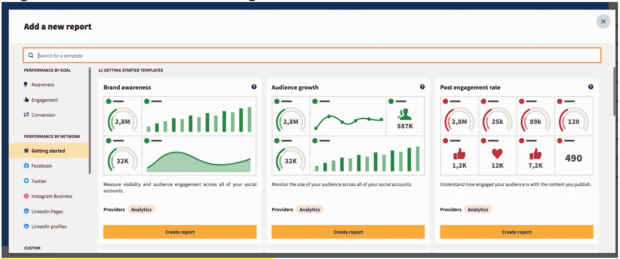
Not all metrics are equally important for every goal, so save yourself a headache by tracking the numbers that actually matter.
Check in regularly
Importantly, social media analytics shouldn’t just be used for “before and after” snapshots of your goal’s impact. Check in regularly on your analytics over the course of a campaign or project with social media reports to ensure you’re on the right track.
“What can’t be measured, can’t be managed,” as the old leadership adage goes. If you just set your strategy and let it play out without any observation, you’re missing opportunities to adjust and adapt along the way.
All the major social media accounts have their own in-platform analytics tools. In fact, here’s a list of step-by-step guides to using the Insights tools for pretty much every social platform you can dream of:
But here’s a hot time-saving tip: Hootsuite Analytics or Impact are great all-in-one tools for reviewing your data at a glance… and, helpfully, scheduling regular custom reports.
With Hootsuite Analytics, each report has a flexible, interactive interface that’s totally customizable: drag-and-drop an unlimited number of “tiles,” each of which displays a specific metric.
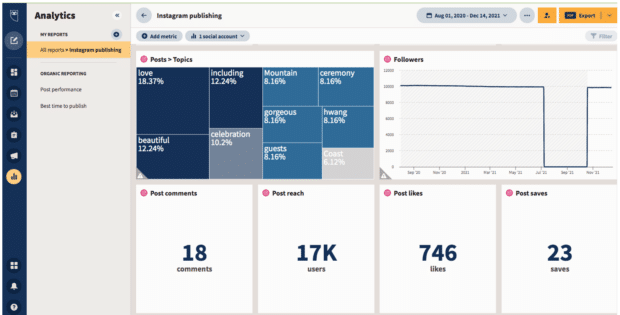
Pick and choose your ideal combination of metrics, or use a pre-existing template. Export right away in the format of your choice, or schedule them for automated email delivery.
Hootsuite Impact is another, pricier but nerdier option that’s part of the Hootsuite toolkit. Impact measures organic and paid content metrics for Facebook, Instagram, Twitter, and LinkedIn, and organic content metrics on Pinterest and YouTube.
Pay attention to spikes and drops
Once you’ve got your piping hot report in your hands, it’s time to analyze these analytics. Social media metrics offer a clue as to what’s going on out there on the world wide web: it’s up to you to interpret what they actually mean.
Look for any spikes and drops in your numbers, and then dig into why those anomalies happened.
Were you running a new, experimental campaign that inspired a ton of comments? Did your product have an unflattering portrayal in a hit television show that turned customers off? You might discover information that helps you either replicate those highs, or avoid another low.
As you monitor social sentiment over time, you’ll start to understand how your messaging can influence the way your followers feel about you (for better or for worse!). By watching for trends and unusual behavior, you can understand more clearly the impact of your messaging and better strategize for future posts.
Use the right tools
Technology is your friend when it comes to social media analytics, and there are dozens of tools out there to help make sense of the numbers.
The right social media analytics tools can help you answer questions like:
- Do my followers comment more on photo posts or text posts?
- Which social media network drove the most traffic to our website this month?
- Should we post more on TikTok next quarter?
- Is it worth it for my brand to keep my Pinterest account active?
- What were our most-liked posts on Facebook this year?
- …and on and on and on. You know, all the juicy stuff.
As you probably noticed in our love letter above, we’re fans of Hootsuite Analytics’ custom drag and drop reporting feature, but if you’re looking for even more awesome analytics tools, check out our list of the best free social media analytics tools here (with a few paid options tossed in for good measure, in case you really want to deep dive into the numbers).
Social media analytics report template
Ready to get started tracking your social media analytics like a true data hero? We’ve got the spreadsheet of your dreams right here. Download our free social media analytics report template and show your team just what a track star you are.
Track your social media performance and maximize your budget with Hootsuite. Publish your posts and analyze the results in the same, easy-to-use dashboard. Try it free today.
All your social media analytics in one place. Use Hootsuite to see what’s working and where to improve performance.
[ad_2]
Source link
